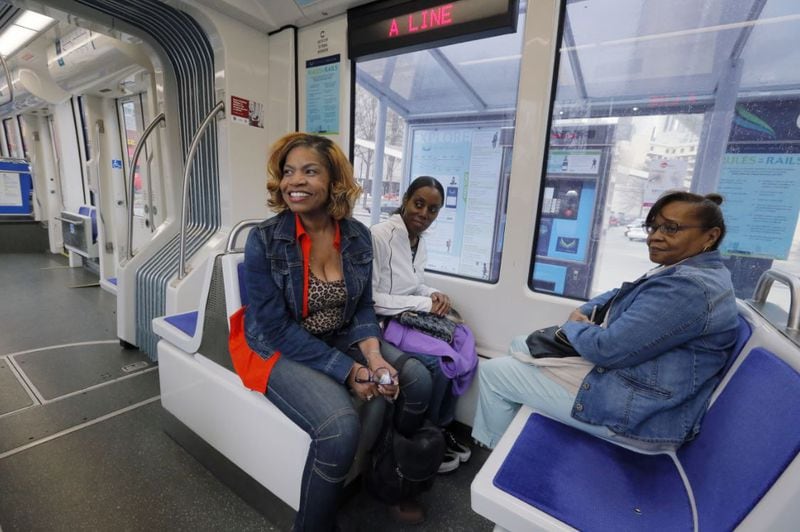Ridership on the Atlanta Streetcar plummeted 58 percent last year as the city began charging to ride.
What’s more, as many as half of those who took a spin on the downtown rail line didn’t bother to pay. That may be one reason Atlanta recovers a far smaller share of its expenses from passengers than some other streetcars around the country.
The declining ridership comes as Atlanta also has struggled to resolve dozens of safety, security, operational and other problems uncovered in state and federal audits.
Yet for all its shortfalls, streetcar supporters contend the ultimate solution would be a major expansion of the system.
Supporters say they’re not concerned about the drop in passengers. They cited a big uptick in riders in January as evidence a turnaround may have begun. And the city recently introduced a mobile app that could encourage more people to pay.
But, bottom line, supporters say: If the streetcar were expanded beyond its modest 2.7-mile loop, more riders would get on board.
“The system has to connect to other forms of transit, and it has to take people to places they want to go,” said William Johnson, the Atlanta public works commissioner who oversees the streetcar.
Critics say it makes no sense to expand a system they see as a failure.
“You’ve got low ridership, and half are not paying,” said Benita Dodd, vice president of the fiscally conservative Georgia Public Policy Foundation. “It’s a recipe for disaster.”
The $99 million streetcar debuted in December 2014, carrying passengers between Centennial Olympic Park and the King Center. The city initially announced it would be free for the first three months, but later decided to forgo charging passengers for an entire year.
The extended “free” period did not yield as many passengers as expected. In 2013, a MARTA consultant estimated passengers would take 1.1 million streetcar trips the first year if they didn’t have to pay. Yet riders ended up taking just 880,083 trips in 2015, Federal Transit Administration statistics show.
Atlanta began charging a dollar in 2016, and the number of passenger trips plummeted to 371,041.
Johnson downplayed the decline in passengers.
“When you’re offering a service for free, you’re going to get much higher ridership than when people have to pay,” he said.
On a recent weekday afternoon trip, most seats on the streetcar were empty, though 10 to 14 people — many of them tourists — rode at any given time.
JoElle Shuman of St. Paul, Minn., was in town for a conference. She rode the streetcar to entertain her 4-year-old son, Knox.
She was underwhelmed.
“We rode it thinking we’d see some things,” Shuman said. “There was no place really that we wanted to get off.”
Janice Gregory of Oklahoma City enjoyed her trip.
“I loved it,” Gregory said as she rode with two friends. “You get more places, the prices are not high.”
Atlanta’s Johnson sees cause for optimism in early 2017 numbers: passengers took 32,934 streetcar trips in January, up 21 percent from the previous January. The big jump came despite the streetcar being shut down for two days because of inclement weather, he said.
But getting people on board is just the first step. Getting them to pay — and to help cover this year's $5.3 million streetcar budget — also has proved difficult.
Johnson said Atlanta does not track how many customers pay. But based on ridership and revenue, he estimated that a third to a half of passengers did not pay in 2016. There’s nothing to prevent someone without a ticket from boarding a streetcar, though employees can check for tickets.
The free rides affect the bottom line. For the current fiscal year the streetcar has recovered just 4.5 percent of its operating and maintenance expenses from passenger fares to date. (The rest of its funding comes from federal grants, Atlanta Downtown Improvement District contributions, Atlanta car rental and hotel/motel taxes, and advertising revenue.)
Other streetcar systems recover far more from passengers, according to a report Johnson delivered recently to the City Council Transportation Committee.
Transit systems with streetcars in Tampa-St. Petersburg, Fla., (30.1 percent); Tucson, Ariz., (20.7 percent); and Memphis, Tenn., (18.5 percent) recovered far more from passengers in 2014.
Among the nine systems included in the report, only Portland, Ore., (4.3 percent) recovered a smaller portion of its expenses from passengers than Atlanta.
Johnson said many factors — including fare amounts, the size and location of streetcars, and the population densities of surrounding areas — could account for differences in passenger revenue. He said Atlanta’s farebox recovery is “typical for systems of this kind and size.”
In December Atlanta introduced a mobile app that allows passengers to buy single rides or long-term passes. It has already been downloaded more than 1,800 times and has generated $3,185 in sales, according to the city report.
Johnson said the app will encourage more people to pay. But he said making people pay is not Atlanta’s top priority now.
“The city’s focus is on improving convenience and access, and on expanding the streetcar to make it an attractive transit option for residents and visitors,” he said.
Dodd, the Georgia Public Policy Foundation vice president, said an expansion doesn't make sense, given declining ridership and other problems.
She said the future of public transit involves ride-sharing and on-demand services. And she fears an expansion will make the streetcar “too big to fail,” encouraging Atlanta to waste more money.
“Why not stop while it’s still manageable?” she said.
About the Author







